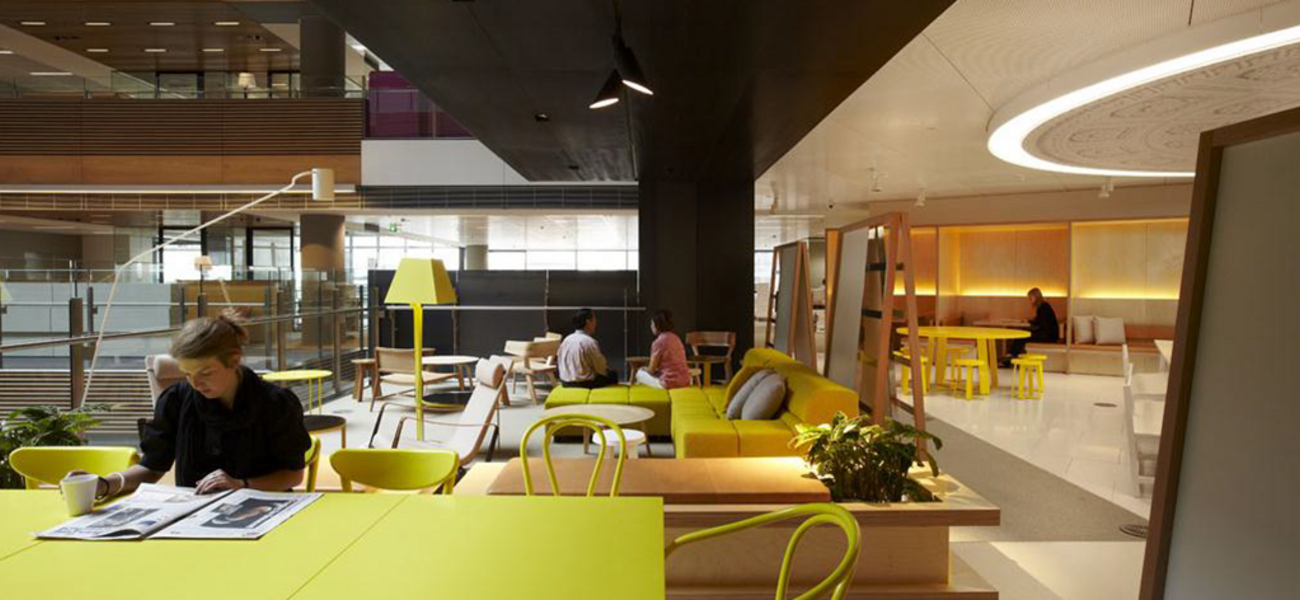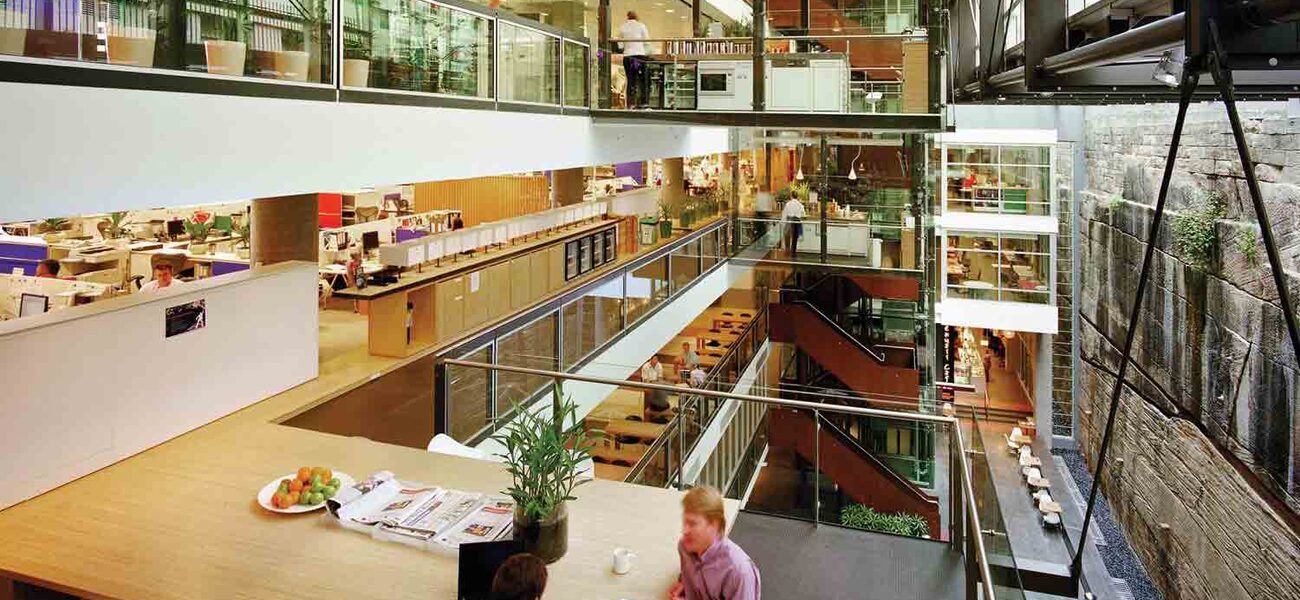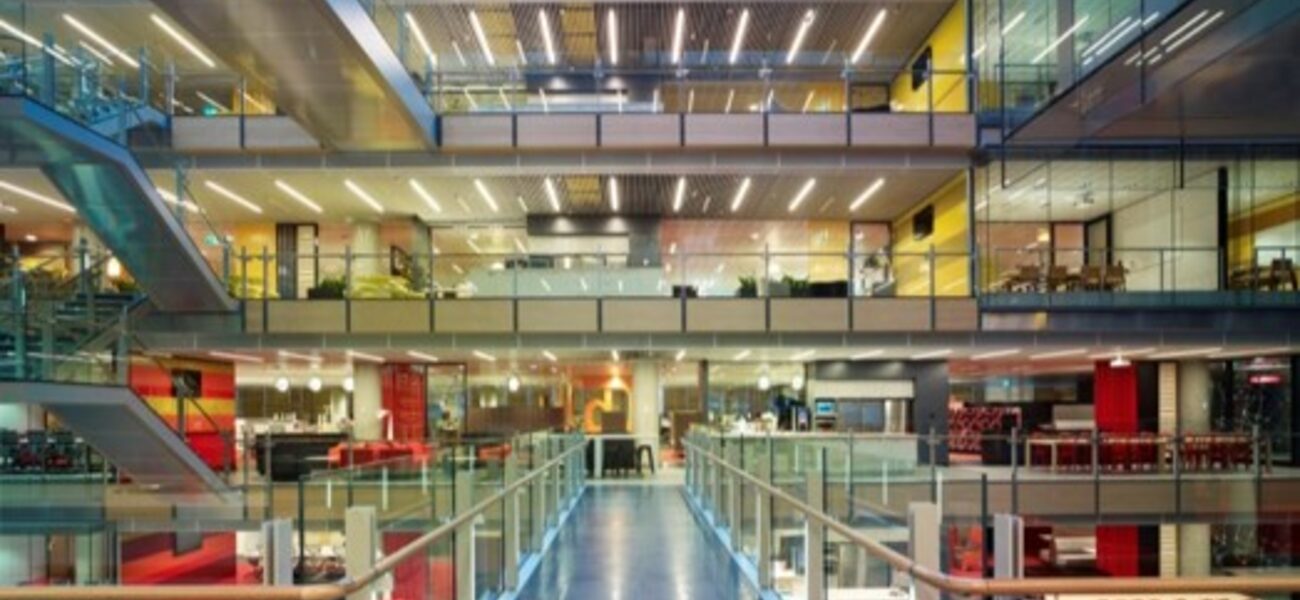Workspace planners are often asked to design to a 10-to-20-year time horizon, but the more rapidly technology advances, the harder this becomes. And it’s not just the hardware, software, and work tasks that are going to change, says Kay Sargent, director of workplace strategies at Lendlease. It’s also the workers themselves. Science shows that workers’ brains are going to work differently in 20 years, says Sargent, and companies need to start planning for this now, or pay the price.
Because workforce costs far outweigh real estate and IT costs, says Sargent, the stakes are high. “Eighty percent of any company’s cost goes to human resources. And according to Gallup’s State of Well-Being Survey, 70 percent of workers are disengaged right now, which means 70 percent of that 80 percent is being flushed down the toilet.” To plan for the future workplace, advises Sargent, we need to start by looking at the people who will be working there, and design workplaces that will engage them.
Today’s Workforce: Four Cohorts
Today’s intergenerational workforce is composed mostly of individuals born between 1945 and 1995, a 50-year span of unprecedented social and technological change. This workforce can be divided into four groups, or cohorts, who share certain characteristics based on the social influences present in their formative years.
- Traditionalists, born from 1925 to 1945, are loyal, formal, respectful of rules and authority, and patriotic. They place duty before pleasure. In the workplace, they highly value job security and being recognized for their experience and dedication.
- Boomers, born in the “baby boom” of 1946 to 1964, are cooperative, optimistic, and idealistic. They highly value personal growth and gratification, and they challenge authority, but they were also the first workaholics. In the workplace, they prefer face-to-face conversations, and seek to be valued and respected as people.
- Generation X, born during the “baby bust” of 1965 to 1980, are skeptical, independent, self-reliant, and entrepreneurial. They were the “latchkey kids” whose parents divorced and mothers entered the workforce en masse; as young adults they witnessed the AIDS epidemic and the end of the Cold War. They were the first generation that didn’t expect to work for one employer their whole career. In the workplace, they value direct communication and dislike being micromanaged.
- Millennials, or Generation Y, born from 1980 to 2000, are realistic, practical, civic-minded, and technologically fluent. Raised by “helicopter parents” in a world made increasingly unstable by both terrorism and the Internet, they are the most highly educated generation yet; one in three of them possesses a college degree. In the workplace, they prefer to be coached rather than managed, and they value challenging work more than high salary or job security.
The latest iteration of the workplace—the Silicon Valley “gameroom” environments marked by bright colors, bold patterns, and a notable absence of walls—is designed to attract Millennials. As a generation, Millennials have been skewered in media reports as lazy, entitled, narcissistic, overly dependent on their parents, and wanting everything immediately. In the workplace, the millennial generation is said to eschew traditional power structures and walls of all kinds. Plugged in 24-7, they are reputed to enjoy noisy, stimulating, unstructured workspaces. They prefer to dress informally and buy environmentally friendly products. They aren’t much into power or status. They change jobs frequently.
The resemblance between the new workplace and a university campus commons is not accidental: These highly stimulating environments are designed to appeal to recent college graduates. The open plan and heterogeneous, random décor also make it easier to switch out technologies, projects, groupings, and workers. Some designers even suspect that Silicon Valley evolved these environments to hyperstimulate young workers’ brains and encourage them to work long hours to extract maximum productivity from them before they leave to form their own startups or burn out.
Often the other cohorts find these work environments distracting, fatiguing, or even outright sickening. And in 10 years, says Sargent, Millennials are probably going to feel the same way. Many of the traits ascribed to Millennials may not outlast their youth; after all, boomers didn’t remain stoned, hedonistic, unemployed hippies the rest of their lives. It’s likely the Millennials will move to the suburbs, have children, and buy SUVs like everyone else.
But what about the generation following the Millennials—Generation Z? They grew up with even more technology than Generation Y did. Won’t they need workplaces that are even more stimulating?
Absolutely not, says Sargent. They are going to need the exact opposite.
Generation Z
Members of Generation Z—born since the year 2000—will have brains that are qualitatively different from previous generations, says Sargent, because they have been wired and multi-modal from birth. “We talk about the Gen Ys always having technology, and that’s true,” she says, “but it wasn’t an appendage to them like it is to Gen Z. My 23-year-old daughter is a Millennial, and she wasn’t allowed to use her cell phone in school, or bring her laptop to class until college. Most of her generation didn’t have a cell phone till they were 12. Today, 50 percent of 2-year-olds have their own iPad or other mobile device.”
Rates of teen depression, attention deficit, and obesity have never been higher, and it’s likely that digital technologies are at least partly to blame. Pervasive technology-related stresses include “always-on” stress, the pressure to be always available, 24 hours a day; “Facebook stress,” the anxiety that results from comparing the mundane reality of your life to the sparkly snippets that your friends post online; emotional detachment and interpersonal difficulties resulting from a shortage of real-time, face-to-face human interaction; and physical inactivity and sleep disturbances. In fact, the World Health Organization predicts that “Techno-stress”—the feeling that you need to be connected 24/7—will be the health epidemic of the next decade.
If employers want their Gen Z workers to be able to do anything requiring more than a couple of minutes of sustained attention, they should plan for work environments that help the Gen Zs to dial down, not up. “These guys don’t need any more stimulation,” says Sargent. “They need comforting, soothing environments that enable them to achieve a higher level of thinking and do what they do best.”
The Next-Next-Generation Workplace
To help Generation Z, and everyone else, focus on work, aim for simplicity and comfort, advises Sargent, and provide a variety of work zones tailored for different kinds of tasks. “Jobs now require different types of activities in the course of a day, rather than the same thing all day long,” says Sargent. To facilitate different kinds of work, Sargent advocates a “team-based environment” that provides, at minimum, three basic zones:
- The hub, a bright, colorful, stimulating, fun community space. People spend shorter periods of time in this area, coming and going throughout the day. Public information, team pictures, and locker banks are located here.
- The neighborhood, work points that are supplemented with an array of cozier work areas with furnishings reminiscent of libraries and dens, and more subdued patterns and colors.
- Focus rooms that eliminate visual and auditory distractions and facilitate highly concentrative tasks.
Be careful where you place the hub, cautions Sargent. A common error is to locate it behind the pantry, because that’s where the water is, but this location is typically in the back of the house, hidden away from window walls, often causing these spaces to be grossly under-occupied. To design the social hub as a destination location, Sargent recommends two basic strategies: make it impossible to avoid, by locating it in a high-traffic area, such as right off a main elevator lobby; or make it exceptionally pleasant, with ample daylight and the best views.
Color is a very powerful tool for making a work environment soothing or energetic, says Sargent:
- Blue is best for focused thinking and contemplation.
- Red is more highly stimulating and facilitates engagement and interaction.
- Yellow fosters freedom and creativity.
- Green is neutral, calming, and connecting.
- Brown (especially wood) engenders feelings of comfort and safety.
Everyone’s eyes are going to need a rest. Reduce visual clutter, simplify navigation, intensify contrast, and provide plenty of light; both the aging Gen Xers and the overstimulated Gen Zs will thank you. And tailor the lighting to the task at hand: Tone it down in areas devoted to more contemplative work, and brighten it up in the hub and other engaging community spaces.
Flexibility, although important, should come second to comfort. “Everyone always wants to make the walls and furniture flexible,” says Sargent. “Several years ago, people wanted to put everything on wheels. And the corridors started to disappear, because people started creating their own spaces, and it was basically anarchy. Bottom line, the most flexible thing in any environment is the people. If you can design an agile work environment where the people have options and choices, then you’re going to be a lot better positioned to plan for whatever changes come.
The agile environment also “encourages movement and spontaneous connections, all vital to creating energizing space,” says Sargent. “After all, we are no longer simply designing work environments; we are creating curated experiences, places people want to be.”
By Deborah Kreuze



